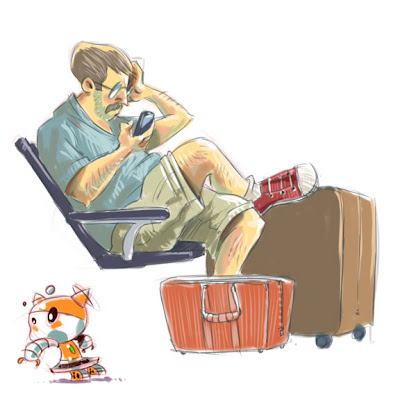For twenty years Walt
Stanchfield taught figure
illustration classes for Disney Studios. But unlike the figure classes I took back in college with Sylvia
Marciniak, where we studied the parts and proportions of the human body, Walt's classes
focused on the figure as it pertains to animation and
storytelling. He would bring in a model who would "perform" poses, usually in costume, for the animators and new students. Walt would often click his pen and draw a quick suggestion next to a student's drawing when he thought they weren't quite getting it. He'd then collect some of these suggestions, as well as lessons on animation drawing
techniques, and some sage advice on life in general, and put it all into multi-page hand-outs that he'd pass around once a week. Over time the number of hand-outs grew and they became sought after, traded, Xeroxed, and posted on the
Internet. After his death in 2000 the hand-outs were collected into two thick volumes called
Drawn To Life: 20 Golden Years Of Disney Master Classes.

I've spent the last couple of months poring over these volumes. I'm not studying to be an animator, but much of the content can be applied to cartooning and
illustration as well, especially those lessons dealing with
storytelling. The one lesson that Walt
continuously brings up is that, as a storyteller, it is not the artist's job to copy the model. Instead, the model is there to act as a guide. It's okay, in fact it's essential, to make changes in your drawing that better serve the story, even if it doesn't match what you see before you. Do not draw what you see because what you see doesn't necessarily represent the story you're trying to tell. Not to say that it isn't important to understand anatomy and being able to draw what you see, but sometimes you will need to translate that pose for a character that isn't human. As an animator or cartoonist, when was the last time you had a talking mouse modeling for you?
Much of what Walt
Stanchfield teaches in these hand-outs deals with drawing from live models and capturing the essence and energy of the story in quick gestures. Forget about the detail. The idea is to capture the story quickly with few lines, gathering just enough information so that the drawing can be refined later on. The monthly Dr. Sketchy sessions that I go to is a perfect place to practice this type of drawing. I've gone on and on about how I'm not happy with the way I draw and how I don't know what I'm doing and
wah,
wah,
wah. I was hoping to put some of Walt's teachings to the test last Thursday. I'm still hung up on producing something akin to a finished work and find myself bogged down in detail, but I think these are an improvement in what I've done recently. Take a look:






































